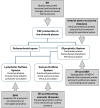The Glymphatic System and Its Role in Neurovascular Diseases
- PMID: 40548139
- PMCID: PMC12182978
- DOI: 10.5797/jnet.ra.2025-0020
The Glymphatic System and Its Role in Neurovascular Diseases
Abstract
Over the past decade, clinicians and researchers have increasingly recognized the significance of the glymphatic system. Evidence demonstrates that this system-named for its reliance on astrocyte endfeet of glial cells and its lymphatic-like waste clearance function from the brain-is essential for regulating the accumulation and removal of amyloid aggregates and other interstitial waste products that may cause cognitive decline if not removed. Its activity is highly regulated, with flow driven by arterial wall pulsatility linked to the cardiac cycle, facilitating perivascular cerebrospinal fluid (CSF) influx into the brain interstitium and its efflux into the venous system. In the present review, we highlight the interplay between the glymphatic system and neurovascular diseases, as well as conditions that are currently being treated by endovascular means, including subarachnoid hemorrhage, idiopathic intracranial hypertension, steno-occlusive disease, and arteriovenous shunting diseases. We describe how changes in arterial pulsatility, disturbances in para-arterial CSF influx, changes in aquaporin-4 receptor composition, or venous hypertension with a decreased arteriovenous pressure gradient can cause dysfunction of different components of the glymphatic system, leading to similar clinical symptomatology with progressive cognitive decline that may be reversible.
Keywords: brain hydrodynamics; cerebrospinal fluid; glymphatic system; idiopathic intracranial hypertension; subarachnoid hemorrhage.
©2025 The Japanese Society for Neuroendovascular Therapy.
Figures




References
Publication types
LinkOut - more resources
Full Text Sources
Miscellaneous

